
Sometimes you need to think really hard about good blog or article topics. Sometimes you need to do a lot of research to really dig into the ideas…and sometimes chance steps in and brings in some real life inspiration.
So the reason we’re going to go straight into surviving an animal attack is because I just narrowly avoided getting mauled by an overly aggressive dog that had stalked, tracked, and hunted me in the middle of a city – then cut me off baring fangs, tensing, and getting ready to lunge and attack.
Quick thinking and knowing what to do helped me fortunately avoid that fight, especially since I was unarmed, and manage to slip away just long enough to get into a store was the animal was distracted and then call animal control.
The weirdest part about this? It wasn’t in the middle of the country while approaching a farm on a gravel road or out in the wilderness in a survival situation. My potentially dangerous encounter with an aggressive dog was two blocks from the First Avenue of a city of 130,000+ people.
Not exactly your conventional wilderness survival setting.

Yet knowing what to do saved me from a serious injury at the very least, and possibly much worse. The dog seemed to be frothing at the mouth – did it have rabies or some other disease? What if tearing up my arms got some teeth into an artery? What if I didn’t keep my balance and ended up on the ground?
Fortunately, I remembered the cardinal rule of dealing with an aggressive dog: don’t make eye contact.
I not only didn’t make eye contact, I looked down at the concrete and turned my head away. It was still in my peripheral, but there was no mistaking my movements as being “beta” or “not a threat.” The dog seemed confused, growled one more time, paced a little in front of me, and with a loud noise turned and went in that direction to see what it was. I used the chance to slip away quickly.
Based on how often I’m alone in the woods, the sheer hours I spent in the wilderness of Alaska completely solo, I always thought that would be a place where these skills would come in handy: not in the middle of a city of hundreds of thousands of people. This is why learning how to survive an animal attack is so important.
As for the all important legal notice: this is the best agreed upon information at the time I am writing the post. It’s not guaranteed, it won’t work 100% of the time, but this is the information that most experts agree upon as being the best actions to take in these situations. But remember, it’s called the wild for a reason.

Table of Contents
How to Handle Dog Attacks
Turns out my old instincts were right. Freezing isn’t a problem when you get the feeling you’re being stalked and then you suddenly see an overly aggressive dog appear in front of you.
Standing as still as possible is critical, and avoiding eye contact doesn’t mean looking over the dog or at the dog’s feet: you need to turn your entire head and stare down. Use your peripheral vision to look at the movement of the dogs’ feet.
You don’t want to risk making eye contact at all. The far majority of the time if you take the proper pose and hold it, avoiding the temptation to look up, this will be enough to make even an aggressive dog eventually lose interest and leave.
Avoiding the mauling is definitely the best way to go, and if all it takes is turning away, avoiding eye contact, then you are set to go. This is not the time to let pride get in the way and remember, despite what some people say, staring and making eye contact with most animals is seen as a direct challenge, if not a threat.
So to review:
- Stand completely still
- Look away from the dog completely
- Keep your head down and never make eye contact
- Keep your hands down at the size
- Move away only after the dog loses complete interest in you
- If the dog attacks anyway, feed it a sweatshirt, a jacket, anything you can put between you and the animal to avoid injury
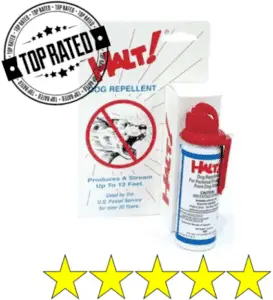
If the actual attack can’t be avoided, you want to put as much between you and the dog as possible as you make your way to a house or business, a ladder, someplace where you can get to safety away from the attacking animal.
The key is to get separation if you can, and if the dog just won’t leave and you’re forced to attack, jab for the eyes.
Avoiding challenging an overly aggressive dog is the best overall strategy to handling the situation.
If you are really worried about a dog attack, consider carrying around some dog spray. It’s not a magical anti-dog force field, but it is very effective against most aggressive dogs and will at least keep them at bay, giving you time to get away to someplace safe where you are not going to get injured by an angry canine.
The fact is, even bear spray was created when testing in a laboratory showed that regular pepper spray or dog spray actually was one of the only things that seemed to have a deterrent effect in a closed setting.
The Humane Society has a great follow up article on this topic you can find HERE.
Surviving Cougar/Mountain Lion/Puma Attacks

This is obviously going to be limited to only certain parts of the country as there are large areas that don’t have reports of mountain lions, but if you like traveling or live in an area where there is a healthy population (especially if encroaching suburbs are starting to cut into their natural territory) then it’s important to understand these attacks unfortunately do happen.
Not very often, but that’s of no comfort to the lone cyclist or trail runner who gets caught off guard in one of those rare moments – and there are multiple instances in recent years of deaths happening because of these encounters, which isn’t surprising considering mountain lions are ambush predators by nature.
Your ideal situation is to see the mountain lion clearly before it attacks. The reason for this is simple: they are ambush predators. Rarely will a cougar ever come straight at someone as an attack. They want an easy attack or an easy kill.
If you see a cougar, you want to make yourself as large as possible. Don’t corner them – give them space to get away, but then you want to stretch and put your arms up and out, especially with a jacket stretched in between them if you have one. You want to look as large and intimidating as possible. Bear your teeth, shout loudly, and make yourself as large as possible
Most of the time, this will be enough to force it to back down. Under no circumstances do you want to run or show it your back, and if you have an air horn with you, that is a great time to use it.
If this puma proves itself unusually devoted to hunting you down, even after all your prevention steps, then you need to fight viciously and not stop. As this article points out, cougars want as easy a meal as possible and your job to survive is to make yourself as difficult a meal as possible – to the point it is just much easier for it to leave you be.
If you’re going to be doing a lot of traveling in cougar country, consider traveling with an air horn. The sound is usually more than enough for a predator’s instincts to switch to “Screw this.”
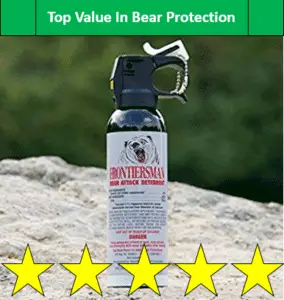
How to Survive a Bear Attack
Surviving a bear attack is a little bit more of a challenge. There are a few reasons for this. One is that bears have wildly different personalities. Not only individually as far as aggressiveness, but you also need to worry about the extra dynamic that comes if a mother is by her cubs or if there has been a lot (or too little) food in an area recently.
In other words, there are many different factors that can contribute to how aggressive a bear is going to be and how likely it is to attack.
There’s also the fact that generally speaking (because no information in this article is going to be 100% accurate a full 100% of the time) different species of bears are going to act very differently and often require completely different actions to increase your chances of surviving an attack.
The Rhyme
There is a general rhyme I learned from my time in Alaska, and it pretty much covers the three main types of bears you would ever run into. The rhyme is overly simple, but it gives a very solid and quick rule of thumb that will help you remember how to deal with the type of bear you’re looking at.
If the bear is brown, get down
If the bear is black, fight back
If the bear is white, say good night
Granted – a bit dark on the outlook if you see a polar bear but in fairness if you do see a polar bear up close and unarmed, it’s probably one of the last terrifying moments you’ll ever have.
Preventing An Encounter
You don’t want to surprise a bear suddenly, especially if there’s a mother nearby with some cubs. Bears tend to have poor eye sight so if they can’t smell you or hear you, you could end up sneaking up on them without intending to.
This leads to a series of basic steps you, and those you’re hiking, camping, or hunting (assuming it’s not bear hunting) with, should always take when in bear country:
- Make noise while hiking. Talk, sing, hum, make it obvious that you’re there.
- Don’t have open food on you, don’t leave a trail of wrappers behind
- Keep a respectful distance if you suddenly see a bear. If you spot a bear or a cub in the distance, don’t head that direction. Stay back or even turn around.
- Don’t stare if one is close – starting and making eye contact is an aggressive move in the animal kingdom. Give them a chance to run first.
- Learn how to use bear spray as this has been proven multiple times to be the most effective deterrent to an overly curious or aggressive bear
Black Bear self defense

Black bears are the least likely to attack and generally are the easiest to intimidate or scare off. Keep in mind that as long as we’re talking about bears and bear attacks, “easiest” is definitely a relative term.
Black bears tend to be the least aggressive of the three types, and taking normal precautions will usually result in them giving you a wide birth.
If you see a black bear it’s important to stand your ground. Don’t turn and run and with black bears never pay dead. Make yourself as large as possible. Shout, make noise, wave your arms. Don’t make eye contact. You want to be make yourself look big and potentially scary, but you don’t want to directly challenge it as a threat.
So in other words, make a lot of noise and make yourself look big and bad without making the direct eye contact mistake. If you can do this, then chances are you will come out of the confrontation in decent shape.
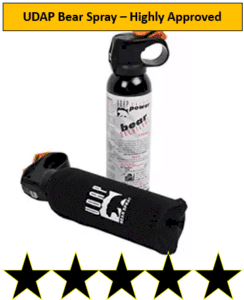
Black bears are also known for making convincing charges but then peeling off and running if you don’t. You need to stand up to a black bear.
However, if this doesn’t work and the black bear does attack, DO NOT PLAY DEAD! This is a good tactic with brown bears and grizzly bears that will “make the kill” then wander off before coming back to eat later, but black bears when they are set on attacking tend to attack, kill, and eat all at once.
This means you need to fight for your literal life. Hit, bite, kick, stab, gouge out the eyes, do whatever it takes to protect your neck and beat the living hell out of the black bear.
While they’re the least likely to attack, once it actually gets to that point you need to fight like hell until the black bear decides you are too much trouble, because it’s not going to stop otherwise. At that point this is your only shot once things escalate to an actual attack.
Brown/Grizzly Bear Self Defense

Carrying around a quality bear spray and understanding the correct way to use it is an important part of being able to defend yourself against a likely brown bear or grizzly bear attack. Generally speaking these bears are likely to be far more aggressive than black bears, and dealing with one of them charging you requires an entirely different strategy.
The bear spray has been shown in BYU studies and published papers to be the most effective deterrent when used properly, as this paper shows. Never go into bear country without it, and make sure you know how to use it!
Well over 90% of the time this will be enough to stop the attack. However if you find yourself in one of those single digit situations where it is not enough, you need to drop to the ground, cover the back of your neck with your arms, and play dead, even when the bear swats at you. With brown bears this is the best way to get them to leave you alone, and you need to make sure you don’t move the moment the initial attack stops. As hard as it can be to stay still, sometimes a brown bear will stay close by for a few minutes and stare to see if you move.
Staying still during this time is critical to avoid a second more aggressive attack. After some amount of time has went by or you hear the bear moving off into the woods, then you can cautiously get up and find a way to move away towards medical help and safety.
Now if it is an incredibly windy day or there is a situation that doesn’t allow for the use of bear spray, you need to have a backup plan, ideally in the form of a very large caliber handgun if you are proficient at shooting it. Bear spray should be the first option, but if you have a 40 mile per hour wind blowing in your face, that’s not going to work.
Nothing under a .357 Magnum or .44 Magnum should be considered. Only the strongest of handguns give you even a fighting chance.
Polar Bear “Self Defense”

Avoid the attack in the first place. This isn’t being completely cute or tongue in cheek. Polar bears are much bigger than brown, black, and even grizzly bears. They are stronger, meaner, and by far and away they are the breed of bear that is less afraid of people.
They are very curious by nature and don’t have the balance of fruit, fish, and meat that other bears eat – polar bears are mostly carnivores and they know they are the absolute top of the food chain. So don’t act like prey.
You really want bear spray if a polar bear encounter turns bad. While extremely rare, these bears are next to impossible to scare off or fight off (barring a gun or bear spray) but you need to make the effort since polar bears hunt for prey (food). Don’t go into any polar bear territory without being properly armed and try to avoid any confrontations with these majestic but powerful animals.
Ideally, you should never be in polar bear territory without a group of armed individuals.
One major note on bear attacks: ALWAYS make sure you take every possible action to discourage bears from bothering you to begin with. Bear attacks are serious business and even when you do everything right and even when you have bear spray or are an expert marksman with a large caliber handgun, bears are top of the food chain. Some will charge right on through so do whatever it takes to avoid confrontation.
If you want more information, check out this great bear attack survival guide from The Art of Manliness website.
Surviving an Attacking Moose
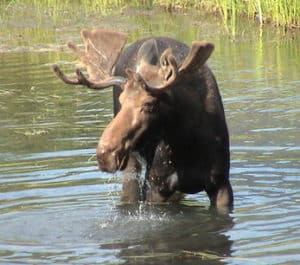
More human deaths are actually caused by moose each year than bears, which goes to show how dangerous this animal can be. Granted, while many of those deaths are due to car accidents, a fully grown moose can be well over 1,000 pounds, hit speeds of up to 35 miles per hour, and are among the few animals that can sometimes cause bears to take off running, full of “Nope – don’t want any of that.”
Generally speaking moose aren’t aggressive but they can be curious, and in the fall it is mating season. Male moose get in the mood by chewing roots that basically get them even further worked up.
Imagine moose on PCP before mating and you get a picture of how male moose feel during rutting. Moose don’t have great vision, so if you keep your eyes open, you can often spot them before they spot you and move out of the potential danger zone. If you do get close, have your hands up, palms out, and slowly back away talking in a very steady and calm voice. Even in a hyped state most moose charges are bluffs designed to show force and make you back off.
If it lets you go, then go. If it charges, make sure to get large materials like trees or rocks in between you and the moose and if you’re stuck in the open, hit the ground and cover your head and vitals the best you can. Don’t fight back.
To learn more check out this article from Glacier National Park Guide.
 How to Survive a Swarming Bee Attack
How to Survive a Swarming Bee Attack
Bee swarms for the longest time were generally not a major issue in most places in the United States, although with the spread of the invasive Africanized honey bees, these bees are becoming more and more aggressive, leading to hundreds of more cases of bee swarms each year.
While non-Africanized bees or wasps might swarm in the right situation, but it is a rarity. Understand that you don’t want to jump in water, you don’t want to swat them away, you want to run as quickly and as far away as possible, looking for shelter like a house, a car, or some type of shelter you can run into that will give you appropriate protection.
Be careful to try not to kill the bees as you run, as killed bees let off a hormone that attracts others and encourage them to attack and swarm even more. Surviving a bee attack is crucially tied to taking the right actions. Getting away is the most important thing, and avoid the mistakes of diving into water or swatting away bees as you fight them.
You need to get away and then once safely in shelter take out stingers and seek medical treatment.
The problem has become common enough that even the USDA has a guide on surviving bee swarms and what actions to take to help increase your odds of surviving. I’ll admit that this one terrifies me personally because I’m allergic to bee stings and this type of situation would be particular dangerous and/or catastrophic.
Survive a Shark Attack
Going to be honest, I’m not nearly good enough at water sports to head that far out in the ocean. While I enjoy hitting the beach off the Gulf of Mexico when visiting Tampa/St. Petersburg, I just don’t swim well enough to take up surfing. However, if you are someone who takes to the water the way I take to hiking trails, this is one of those things you need to be prepared for. Even CNN agrees.

Granted – it’s important to note that shark attacks are extremely rare and there are very few species of sharks that will actually attack a person whether swimming, surfing, or kayaking. There are many surfers who have gone out on the water not only for years but for decades and have never had a close call with a shark.
However, if you should find yourself in that situation the first step is to not be easy prey. Try to maintain eye contact. While this is bad advice with many land predators, sharks want to ambush you and will be put off or feel uncomfortable if they can’t get behind you. Likewise if you appear larger, you will get a little big more respect as they attack, making it more likely they will be willing to peel off for easier prey.
Don’t panic and splash or wave around wildly. These types of movements will only attract more attention.
If the shark keeps attacking you need to stay alive and hit any sensitive areas. Gouge the eyes, jam up the gills, and if you have a surfboard or other inanimate object or weapon close by, make sure to use it and do your best to keep that stuff between you and the shark’s mouth.
Be frustrating to the shark, make it hard as possible for it to get any of a meal from you. Slowly back away when you get a chance, making sure the shark never gets a clear angle to swim behind you and attack from behind.
Alligator & Crocodile Attack Survival Tips
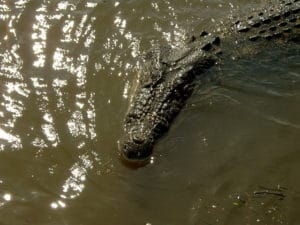
The good news is that these attacks tend to be the easiest to avoid. Both alligators and the more aggressive crocodiles tend to stay in very specific climates and areas. Hot, wet, and swamp-like or wetlands in semi-tropical or tropical climates. Avoiding the habitat of these creatures is the best way to avoid tragedy.
However, if that is not an option, make sure to do your research and understand how to exercise caution when things are the most dangerous. These animals are most active at dusk and dawn (although they can still cause problems during other parts of the day) and they are super aggressive during breeding season.
They are almost always going to be found near a water source, so be extra aware of your surroundings and stay away from the edge of water. Never set camp there, and be cautious using watercraft.
Light canoes, kayaks, or paddleboats can be attacked and flipped, and an aggressive crocodile has no problem trying to do just that.
If you do find yourself bit, fight like hell and do not let them get you into the water. Jam the eyes and the throat and the moment its bite loosens, pull your limb free and run. No matter how bad the damage to the limb or even amputation, it’s preferable to being eaten to death. These animals are all about the ambush and cannot run very fast on land for long periods of time so once you’re free if you start running you should be in good shape.
This Wiki article goes into more good details about taking the right safety precautions and breaking down what to do when the worst case scenario happens.
Surviving Venomous Snake Bites

Generally speaking they don’t “attack,” but among the ways an animal in the wild can kill a person it’s irresponsible to ignore venomous snakes. While snake bite related deaths are extremely rare in the United States, there are up to 8,000 venomous snake bites treated in the United States per year and even the ones that are “minor” and have no threat of death or amputation can cause extreme pain and swelling.
Many of these hospital or clinic treatment bills will run in the tens of thousands of dollars and that is assuming everything goes relatively well. The truth is that during the weeks after you may still have severe swelling, skin and flesh damage, and be in severe pain, as well. Get a good pair of snake boots or gaiters and exercise normal caution in order to keep yourself as safe as possible when it comes to avoiding venomous snake bites.
If you want to see the best resource online for how to protect yourself and get the best venomous snake bite prevention available, take a look at our perfect snake boot guide article and get all the information you need to make an informed decision so you can boot up and walk with confidence!
Which Animal Is Most Dangerous To Humans?
This can be a tricky question, and I’m going to answer this after setting some ground rules to avoid the type of annoying or cute answers that don’t really answer the intention of this question. So the rules here:
- Humans don’t count
- We acknowledge the power of disease via mosquitoes, and don’t count them
- Looking at first world countries (big difference in venomous snake bite deaths, for example, when the issue of anti-venom availability comes into play)
While these will vary from place to place and based around where a person is located (more moose related deaths in Alaska & Canada than New Mexico or Texas, for example), we’re going by general numbers.
And the CDC released some interesting data on this over the years and although this can change from year to year, one group of animals kept coming up surprised us and they sometimes ended up first in a year, creating a surprising “deadliest animal,” one that often kills far more people than bears, sharks, moose, and aligators combined.

Yup, that’s right. Cows. Whether in Australia, the United States, or even Canada, more people are crushed or trampled by cows than are killed by the animals that many of us fear. This shows just how rare death by animal is, and why it’s still important to always be kind of aware of what’s going on.
To no one’s surprise dogs and bees are high on the list, but cows are right up there year after year, showing that you first gut instinct isn’t always going to be right on when it comes to preparing to deal with the true most dangerous animals versus the ones that look like they should be the most dangerous.

In Conclusion
One thing we want to make clear is that we don’t want to discourage anyone from enjoying the great outdoors. These types of confrontations are extremely rare even if you tend to forget a lot of the prevention steps or not do them well.
That being said, prevention is going to be a far better strategy than getting to the point where you need to fight or flee in order to survive.
However, learning how to make yourself safer and to take a few basic steps to minimize your chances of these violent encounters will help you enjoy the outdoors even more.
Explore. Camp, hike, see the wild, cross your adventures off that bucket list: believe me when I say from experience that there will be plenty of adventure left without having any animal attacks or confrontations to worry about!
So enjoy – just prepare to be safe as you go out and make those (overwhelmingly) beautiful lifetime memories.

